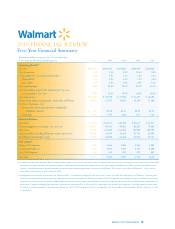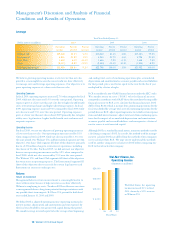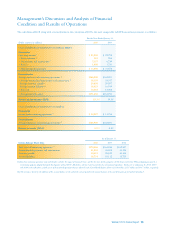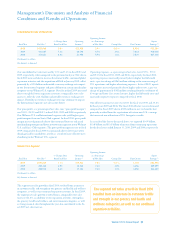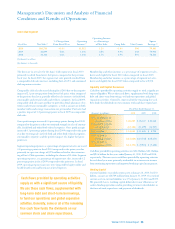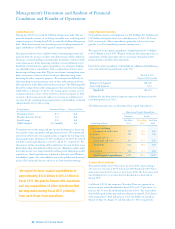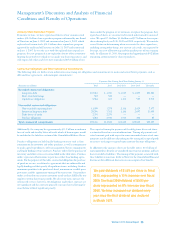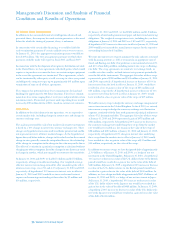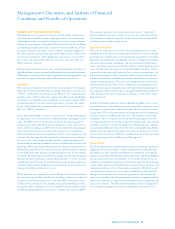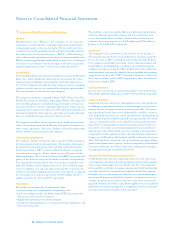Walmart 2010 Annual Report Download - page 27
Download and view the complete annual report
Please find page 27 of the 2010 Walmart annual report below. You can navigate through the pages in the report by either clicking on the pages listed below, or by using the keyword search tool below to find specific information within the annual report.
Company Share Repurchase Program
From time to time, we have repurchased shares of our common stock
under a $15.0 billion share repurchase program authorized by our Board
of Directors on June 4, 2009 and announced on June 5, 2009, which
replaced and terminated a $15.0 billion share repurchase program
approved by our Board of Directors on May 31, 2007 and announced
on June 1, 2007. As was the case with the replaced share repurchase
program, the new program has no expiration date or other restrictions
limiting the period over which we can make our share repurchases, and
will expire only when and if we have repurchased $15.0 billion of our
shares under the program or we terminate or replace the program. Any
repurchased shares are constructively retired and returned to unissued
status. We spent $7.3 billion, $3.5 billion and $7.7 billion in share repur-
chases during fiscal year 2010, 2009 and 2008, respectively. We consider
several factors in determining when to execute the share repurchases,
including among other things, our current cash needs, our capacity for
leverage, our cost of borrowings and the market price of our common
stock. As of January 31, 2010, the program had approximately $9.2 billion
remaining authorization for share repurchases.
Management’s Discussion and Analysis of Financial
Condition and Results of Operations
Walmart 2010 Annual Report 25
Contractual Obligations and Other Commercial Commitments
The following table sets forth certain information concerning our obligations and commitments to make contractual future payments, such as
debt and lease agreements, and contingent commitments:
Payments Due During Fiscal Years Ending January 31,
(Amounts in millions) Total 2011 2012-2013 2014-2015 Thereafter
Recorded contractual obligations:
Long-term debt $37,281 $ 4,050 $ 6,049 $ 6,899 $20,283
Short-term borrowings 523 523 — — —
Capital lease obligations 5,584 607 1,103 959 2,915
Unrecorded contractual obligations:
Non-cancelable operating leases 13,099 1,275 2,318 2,029 7,477
Interest on long-term debt 29,296 1,762 3,138 2,697 21,699
Trade letters of credit 2,370 2,370 — — —
Purchase obligations 4,283 2,936 1,014 248 85
Total commercial commitments $92,436 $13,523 $13,622 $12,832 $52,459
Additionally, the company has approximately $11.2 billion in undrawn
lines of credit and standby letters of credit which, if drawn upon, would
be included in the liabilities section of the Consolidated Balance Sheets.
Purchase obligations include legally binding contracts such as firm
commitments for inventory and utility purchases, as well as commitments
to make capital expenditures, software acquisition/license commitments
and legally binding service contracts. Purchase orders for the purchase of
inventory and other services are not included in the table above. Purchase
orders represent authorizations to purchase rather than binding agree-
ments. For the purposes of this table, contractual obligations for purchase
of goods or services are defined as agreements that are enforceable and
legally binding and that specify all significant terms, including: fixed or
minimum quantities to be purchased; fixed, minimum or variable price
provisions; and the approximate timing of the transaction. Our purchase
orders are based on our current inventory needs and are fulfilled by our
suppliers within short time periods. We also enter into contracts for
outsourced services; however, the obligations under these contracts are
not significant and the contracts generally contain clauses allowing for
cancellation without significant penalty.
The expected timing for payment of the obligations discussed above
is estimated based on current information. Timing of payments and
actual amounts paid with respect to some unrecorded contractual com-
mitments may be different depending on the timing of receipt of goods
or services or changes to agreed-upon amounts for some obligations.
In addition to the amounts shown in the table above, $1.0 billion of
unrecognized tax benefits are considered uncertain tax positions and have
been recorded as liabilities. The timing of the payment associated with
these liabilities is uncertain. Refer to Note 8 to the Consolidated Financial
Statements for additional discussion on unrecognized tax benefits.
We paid dividends of $1.09 per share in fiscal
2010, representing a 15% increase over fiscal
2009. The fiscal 2009 dividend of $0.95 per
share represented an 8% increase over fiscal
2008. We have increased our dividend every
year since the first dividend was declared
in March 1974.


